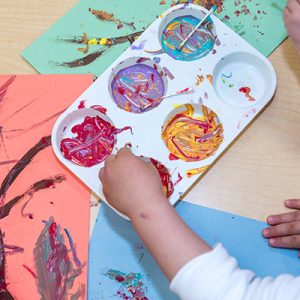 The correlation between colour and the brain has fascinated psychologists, neuroscientists and other scientists for many years. They’ve presented several studies that show how colours affect our moods, feelings and behaviours. Their findings have gone on to influence the way we decorate our homes, what we wear to a courtroom, how we promote products and other key areas of our lives.
The correlation between colour and the brain has fascinated psychologists, neuroscientists and other scientists for many years. They’ve presented several studies that show how colours affect our moods, feelings and behaviours. Their findings have gone on to influence the way we decorate our homes, what we wear to a courtroom, how we promote products and other key areas of our lives.
Perhaps the group that is most obsessed with colours is young children. Their brains may not be fully developed, but they can process images around them. This is why we must create stimulating environments that are suited for each stage of their development.
Should colours be included in these environments? Do they play a key role in early learning? Experts posit that these colours can enhance early learning:
![]() Blue- A top choice because it encourages creativity. A cool blue can help your child to relax. On the other hand, too much blue (especially darker blues) can dampen your baby’s spirit.
Blue- A top choice because it encourages creativity. A cool blue can help your child to relax. On the other hand, too much blue (especially darker blues) can dampen your baby’s spirit.
![]() Yellow – This colour has the power to make children and their teachers happy. Just like the sun, it adds energy to a room and radiates warmth and zest.
Yellow – This colour has the power to make children and their teachers happy. Just like the sun, it adds energy to a room and radiates warmth and zest.
![]() Orange – It has been proven to enhance critical thinking and memory. It may also be useful in the rooms of children who have difficulty socializing.
Orange – It has been proven to enhance critical thinking and memory. It may also be useful in the rooms of children who have difficulty socializing.
![]() Purple – This colour also promotes creativity. Parents and teachers of hyperactive children can use it to help them to calm down.
Purple – This colour also promotes creativity. Parents and teachers of hyperactive children can use it to help them to calm down.
![]() Green – It’s an excellent option as a calming colour that provides mental clarity.
Green – It’s an excellent option as a calming colour that provides mental clarity.
Let’s explore the significance of colours in each stage of early learning.
0 to 3 months
As a newborn, your baby’s vision is monochromatic. This means that in their world, everything is either a shade of black, white or grey. It would be pointless to introduce other colours at this stage because they will not have any effect on your baby’s cognitive development.
Make the most of this stage by including clothes and toys that reflect contrasting patterns and shapes with a monochromatic colour scheme. You can also use this colour scheme to decorate their room.
Your baby will benefit from this environment as patterns and shapes in black, grey and white send the strongest visual signals to a baby’s brain, thereby accelerating their visual development and strengthening their nervous system.
Consequently, a visually stimulating environment can boost your baby’s attention span and improve their memory.
3 to 6 months
You’ll notice your baby’s growing curiosity from 3 to 6 months, thanks to their exposure to monochromatic patterns and shapes. Their visual ability is improving too, so now they’ll notice bright colours.
Adding pops of bright colours to the monochromatic colour scheme is a perfect way to introduce them to the spectrum. A green teddy, a pair of yellow curtains or a light blue accent wall could make all the difference to your baby’s visual development. Similarly, you could use crib linens in cool colours such as blue and purple to help them sleep better.
6 to 12 months
Between 6 and 12 months is the perfect time to play with a wider colour scheme because your baby’s vision is now fully developed. However, that doesn’t mean that you should go overboard. As fascinated as your child may be with colours, you should gradually add colours to their space. Bright colours can dominate other sections of the house but may be too much in the nursery.
On the other hand, bright colours may be useful in toys, books and other learning materials. This will foster and stimulate your child’s sensory development.
12 to 24 months
As a toddler, your child starts to develop verbal communication skills. They’ll also try to demonstrate their ability to differentiate colours. This presents a grand opportunity for you to teach them and get useful feedback.
Engage them in fun activities that are based on colours. Introduce more colours and prints to stimulate their cognitive development even more.
2 to 4 years
As a preschool student, your child will have fun identifying the colour of trees, flowers, their sippy cups and so on. They’ll thrive in classrooms that are colourful and visually appealing. Wall art and colourful letter blocks will do wonders for their colour recognition skills.
5 years and older
By the age of 5, your child would have shared that they have a favourite colour. Having a favourite colour is great because it’s indicative of a blossoming personality. Give them a chance to express themselves while encouraging them to embrace other colours.
In preschool, they will be engaged in fun games that test their ability to identify colours. Finger painting and nature walks are, of course, crowd-pleasers. They may have also picked up some mathematical skills while using the abacus. Their learning experience will be further enhanced when they interact with other children in a colourful playground.
Rothewood Academy
Rothewood Academy presents a fun and creative atmosphere for our future leaders. We are passionate about early learning as it lays the foundation that our children need to become all that they’re meant to be. Talk with us about our curriculum, which caters to children ages 1 to 5.

Leave a Reply